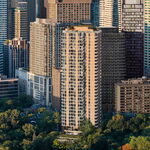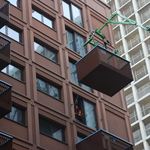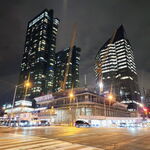hw621
Senior Member
^This is assuming GO RER will move ahead....
Agreed!I attended the last meeting for the west end stations at Lithuania House.... by far the single most vocal issue was the concern over trains ringing bells at the stations, given the increased frequency of trains and the densities around these stations. Seemed like a reasonable concern after the UPE Bloor/Weston experience, and one which other countries have reasonable solutions for, eg instead of bells, use the platform PAs to warn of approaching trains.
I see this issue, while documented, has been neatly sidestepped.
- Paul
Where's eglinton west smarttrack? I'm very impatient with the delays
Where's eglinton west smarttrack? I'm very impatient with the delays
The last direction from City Council (here, Dec 5 2017) called for the next report back by Q2 2018.... which is about now.
Doesn't seem to be on the current Council meeting agenda. The next Council meeting is July 23rd.
- Paul
I hope there is political meddling by Ford because on this one thing he is right...……….Eglinton should be a completely grade separated /subway system. Eglinton having at-street crossing for 40% of it`s length was Miller stupid and short-sighted idea who`s first priority was to `create complete streets` even though the DM to Kennedy station is mostly industrial/ heavy commercial and second priority being Miller was bound and determined to make sure Toronto had no new grade separated transit anywhere so that the system could not be automated and hence offend his union backers.
I hope there is political meddling by Ford because on this one thing he is right...……….Eglinton should be a completely grade separated /subway system. Eglinton having at-street crossing for 40% of it`s length was Miller stupid and short-sighted idea who`s first priority was to `create complete streets` even though the DM to Kennedy station is mostly industrial/ heavy commercial and second priority being Miller was bound and determined to make sure Toronto had no new grade separated transit anywhere so that the system could not be automated and hence offend his union backers.
That might divert so much ridership from the parallel routes that the central section will be overwhelmed.
In any case, we already built the central section of Eglinton for medium-capacity (well below the subway capacity), and that means we need to be careful with adding too much grade separation at the edges. That might divert so much ridership from the parallel routes that the central section will be overwhelmed.
Eglinton Station can't be worse than Bloor-Yonge right? Or will the double single centre platforms not be able to handle the load?IMO, that's impossible within a 30 year period. Eglinton East + Eglinton West have similar potential capacity together as Yonge South after automation upgrades.
For Eglinton to be overwhelmed either a large majority of the capacity of Yonge is used by Eglinton passengers (most Yonge trains short-turn at Elginton because that's as far as riders are going) OR Eglinton would need a wildly different ridership pattern than Bloor Danforth (where ~50% of passengers transfer southbound in the morning).
Additional southbound capacity (like the DRL to Eglinton and Don Mills) would significantly reduce pressure on the central portion of Eglinton too.
In short, I expect Eglinton capacity to be artificially reduced (by order of the fire chief) due to Yonge being overloaded long before Eglinton itself is at capacity.
Trains will be full of course (TTC doesn't run excess capacity very often); but it'll be full like Sheppard (standing room only trains but running at fraction of built capacity), not full like Yonge (where tunnels have actually reached their limit).
For Eglinton to hit built capacity before Yonge hits capacity, Eglinton & Yonge needs to become the new South Core with millions of sqft of office space built.
Eglinton Station can't be worse than Bloor-Yonge right? Or will the double single centre platforms not be able to handle the load?
If you think about it, you're actually saying is that if we get people to communte with public transit it's a bad thing.In any case, we already built the central section of Eglinton for medium-capacity (well below the subway capacity), and that means we need to be careful with adding too much grade separation at the edges. That might divert so much ridership from the parallel routes that the central section will be overwhelmed.
If you think about it, you're actually saying is that if we get people to commute with public transit it's a bad thing.
A transit line is designed to the number of people who want to use it, not sized to prevent people from using it.




